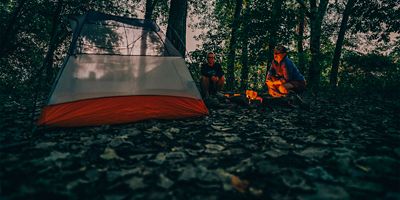From expansive mountaintop vistas to waterfall-laden hollows, Shenandoah National Park offers an awe-filled escape from the big cities of the mid-Atlantic. Located an easy drive from Washington, D.C. and Baltimore—and less than an hour from Charlottesville, Virginia—Shenandoah hugs the crest of Virginia’s Blue Ridge Mountains. The park consists of almost 200,000 acres, nearly half of which are designated wilderness. It’s also home to over 100 miles of the iconic Appalachian Trail, making the park a meca for hiking, backpacking, fishing, and leaf-peeping alike.
From Forest to Summit
Shenandoah’s landscape features rich Eastern deciduous forests, dozens of streams (with plenty of hidden swimming holes), waterfalls, and wide-open ridgelines and summits. The park’s length and varying elevations support a wide variety of ecosystems and plant life, from oak-hickory woodlands to rocky outcrops that host rare vegetation and animal life. In spring, wildflowers decorate the forest floor, and summer brings a thick canopy of leaves and sunny hiking weather. In fall, the mix of hardwoods puts on one of the best foliage shows you’ll ever see, and come winter, snow turns the mountainous landscape into a winter postcard.
Animal Life
Everywhere in Shenandoah, keep your eyes peeled for the park’s stellar wildlife. Black bears, deer, and wild turkeys roam through the forests. Bobcats, spotted skunks, big brown bats, and coyotes make their homes here, too. Eighteen species of snakes can be found (only two are venomous—timber rattlesnakes and copperheads). The park also plays host to several kinds of turtles, salamanders, and nearly 200 types of birds, from barred owls to tufted titmice.
History
Long before Shenandoah became a national park, it was home to Indigenous people who formed lasting communities and farmed the valley areas. The Manahoac, Shawnee, Catawbas, and Cherokee peoples (among others) are thought to have lived in the region. White colonists came to the Shenandoah area in the late 1700s and stayed there until the creation of the park in 1935 displaced them. In the 1930s, the Civilian Conservation Corps (CCC) worked on a variety of significant projects in and around the park, many of which you can still see today.
Visiting the National Park
Shenandoah is a long, skinny park, spanning 105 miles from Front Royal on the north end to Rockfish Gap on the south. The famously scenic Skyline Drive winds through the higher elevations from one end to the other, connecting the major highlights. Along the way, you’ll find two visitor centers, numerous trailheads, preserved historic buildings, and 70-plus scenic overlooks, plus lodging options, restaurants, and gift shops. There are no public transportation options within Shenandoah, so you’ll need a car to get around.
Seasons
Shenandoah is open year-round, with each season offering a distinct reason to visit.
Spring (March through May) brings a wide variety of wildflowers, starting with small spring ephemerals and progressing from tiny violets and other blooms on the forest floor to showy azaleas and rhododendron in May and into June.
Summer (June through August) is the high season, so expect crowds as well as active wildlife and leafed-out trees. Temperatures tend to be relatively moderate, but bring layers and plenty of water.
Fall (September through November) brings cooler temperatures and spectacular fall foliage, which typically peaks in the second half of October.
Winter (December through February) can be cold and blustery, and many services shut down—but it’s also quiet, and the bare trees grant amazing mountain vistas.




